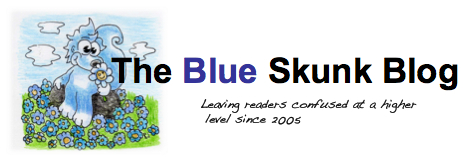BFTP: One monkey, one keyboard
 Sunday, November 13, 2011 at 07:37AM
Sunday, November 13, 2011 at 07:37AM A weekend Blue Skunk "feature" will be a revision of an old post. I'm calling this BFTP: Blast from the Past. Original post February 2, 2007. Seems like blogging has dropped off - the original post contained a lot of names of folks who no longer blog (or at least I don't follow).
We've heard that a million monkeys at a million keyboards could produce the complete works of Shakespeare; now, thanks to the Internet, we know that is not true. - Robert Wilensky
Vicki Davis asked me about how I go about writing my blog. She herself shares a well-composed, serious and insightful post on this topic. She will be disappointed in what she reads here, I am afraid. But then I have never yet let my own ineptitude stand in my way of doing something.
own ineptitude stand in my way of doing something.
I write about what interests me. Period. I write about what is rattling in my brain at the time. I write about things I may wish to remember someday. I write in praise of other writers, but not often enough. I write about things of no consequence but that I can say in a clever way.
When I write on professional topics, which is the majority of the time, I do it for the same reasons I write for professional publications. And that boils down to a little poem by Minnesota author Fredrick Manfred I like, "What About You Boy?":
…Open up and let go.
Even if it’s only blowing. But blast.
And I say this loving my God.
Because we are all he has at last.
So what about it, boy?
Is your work going well?
Are you still lighting lamps
Against darkness and hell?
OK, so that may be a little over the top, lighting lamps against darkness and hell and all, but you get the drift.
There are some absolutely delightful ways blogging is different from writing for print:
- I can write to amuse and no other reason. For a genuine smart ass like me, the worst thing in the world is to come up with something I think is terribly clever and not have someone to tell it to. Now I do.
- I can think out loud. I believe most blog readers don't expect fully polished, fully documented treatises on topics. This blog has been a source of rough drafts for columns and papers. I can be half-baked here, collect some feedback, and improve.
- I can write in a more personal voice. It is really nice not having a editorial presence peering over one's shoulder saying things like, "You can't write bullshit," when bullshit is exactly the word that is needed. Some editors I've encountered feel humor has no place in professional writing. I'll bet they're fun at parties, too.
- I can write on more personal topics. The blog writers I enjoy the most and respect the most are those who both write seriously and readably about their profession, but are not afraid to let their personal lives leak in. I will not forget Miguel Guhlin's moving tributes as his father was dying, Kathy Sierra's t-shirt modeling entries, or David Warlick's tales of missed flights and workshops that have gone in strange directions. So this blog sometimes is my version of "Say, may I bore your with some pictures of my beautiful children and grandchildren? My lovely wife? My last vacation?" Which I can do because...
- I can write knowing that the Blue Skunk blog is on nobody's required reading list and costs nobody anything but the time it takes to move to the next feed in the aggregator. No advertising revenue depends on the popularity of this blog. I have never checked the Blue Skunk's "rankings" nor do I intend to start. I simply assume my blog is someplace in the middle of things - more read than some, less read than others. If you are not amused, informed, aggravated, or whatever by this blog, adios, nice knowing ya, and don't let door smack you on the way out. I am only writing for smart people who have taste anyway. The Blue Skunk is the bistro of blogs, not the all-you-can-eat buffet.
I write in my blog when I just plain want to write for fun. As anyone who writes regularly knows, the writing process can be excruciatingly painful or excruciatingly pleasurable. It's always a pleasure to blog. This was as fine a way to spend a lunch hour as I can imagine. Well almost.
Sorry, Vicki. But you asked.










